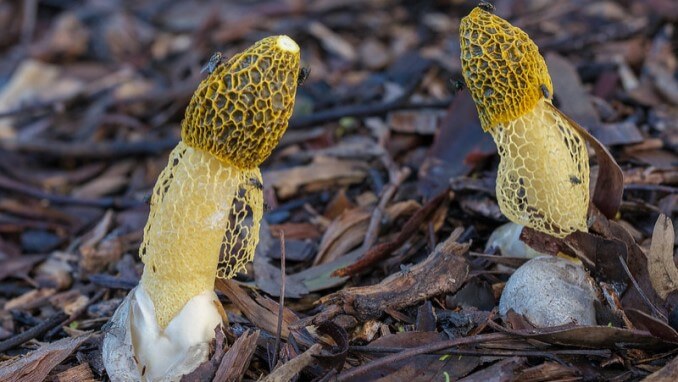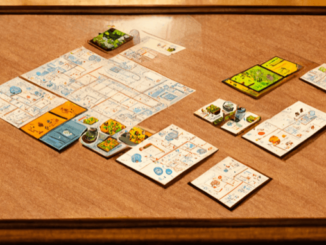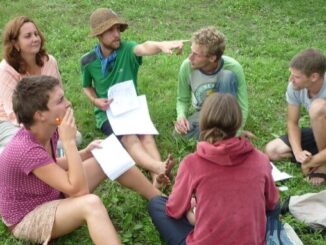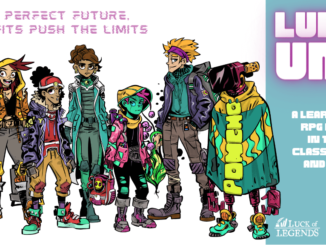
I recently received an article from Leslie Robinson, which described her experience of a ‘visitation’ from a game, which came to her , almost fully-formed, even though she had no desire or intention to get into games design.
A similar thing has been happening to me, over the past few weeks, after reading a report in the Guardian Newspaper about how fungi can communicate with each other, using a vocabulary of up to 50 ‘words’.
I immediately felt drawn towards the idea of making a game from this, but never really considered that it would be anything beyond a bit of fun, that it would take up such a lot of my time and attention, or that it had potential to turn into a complex learning game with multiple applications.
It’s still not finished, and the first playtest won’t be happening for a few weeks, but already this has been a very different experience for me than almost every other game I have designed. Mechanics have emerged from contemplation of theme, and by reading around the topic of fungi. But, more than that, I feel that rather than my ‘designing’ the game, I have discovered it, almost as if the game has revealed itself to me.
Do we Find Ideas, or Do They Find Us?
This is not an unusual experience in creative work, and writers and artists often describe similar phenomena. I remember listening to a TED talk by Elizabeth Gilbert, where she recounts the poet’s Ruth Stone’s experience of having to run back into the house from outside, in order to ‘catch’ (using pencil and paper) the poem she had heard thundering towards her across the landscape.
It is only recently that ‘genius’ has been thought of as a characteristic of a person. Previously a ‘genius’ was something external; inspiration from elsewhere which would visit you and help you to create. Perhaps the idea of a ‘meme’ (not in the social media sense) comes closest to this, these days, being the concept that an idea has an independent existence from those who are ‘having’ the idea.
This is a speculative project. No client has set me a brief, and maybe that has something to do with it. In learning game design, one almost always starts from learning objectives, and then seeks to create a game to deliver those. The ‘fun’ of the game is immediately constrained by having to ‘fit’ with those. That is not to say that the game, when designed, will be less fun to play, but only that the kinds of play (and fun) that end up in the game, have been created in service of specific learning outcomes.
Fun is Learning, and Learning is Fun

In passing, I will mention a talk which I gave at Gamicon48V in May 2022. I won’t dwell, because it is beyond the scope of this article, but it focuses on the idea that ‘fun’ is derived from learning, and so suggests trying an exercise where you approach design with the only outcome being to create a fun experience. A learning topic will be involved, because the experience you create will have to be ‘about’ something, but that is secondary. The tricky part of this exercise for most games-based learning practitioners will be to pull themselves away from the idea of ‘learning outcomes’ and to instead make their only focus the creation of ‘fun’. It’s an experience very like the ‘Don’t think of a White Bear’ exercise.
The outcome of using the ‘fun first’ is very similar to the ‘traditional’ learning game design – you will most likely end up with a game, or something very like a game. And it’s a subtle distinction in practice. Instead of asking, and answering, questions such as ‘What game feature will support the learning outcome “recall and give examples of the seven key GDPR principles?”’, you will be asking ‘How can I use the seven key GDPR principles to support a fun experience?’
A Different Experience of Learning Design
However, the experience of working in this way is very different. Where the play is the point, rather than the learning, it feels like a much freer process of exploration – going where the ‘genius’ takes you. This is design itself as a form of play. I will use the experience of exploring mushroom communication as an example to explain this further.
Initially, my first thought on reflecting on the Guardian article was to create a small ‘lyric game’, similar to ‘Gift Horse’, which would have been little more than an individual or a small group of people listing the 50 words that they would want to be able to keep if these were the only words they could ever use – a bit like a lexicological Desert Island Discs.

Almost immediately, I began to see that even that very simple idea, if played individually, had a lot of potential to gain insight into the concepts that are most important to you. In fact, played individually, there is no actual communication involved, so the words are almost entirely about wanting to be able to think (alone) about specific concepts – if one subscribes to the idea that without the word for something, one does not have the concept for the thing either.
An Emergent Culture
When that idea is taken into a game played with others, it immediately suggests that the game is about building a ‘culture’ of some kind. A short reflection on what that meant for the learning potential of the game, gave me the first glimpse of the emergent complexity of what I was building. Furthermore, if you play it in a group, you could simply bring your allotted number of words to the game (50 / number of players), or there could be a mechanism to ‘accept’ or ‘refuse’ the suggested words brought by other players, so that the game becomes more than an interesting but trivial insight into someone’s top 10 favourite words.
A (non-exhaustive) list of ideas that emerged from this were:
- It is a game about negotiation, about what the culture of an organisation should be ‘about’.
- There are words which will be about the ‘housekeeping’ of being in a group, which could be considered mundane, and those which are about the ‘higher self’
- If players bring their own choices of words to the game, who will bring the ‘mundane’ words? Will people hope that others do this, so that they can focus on the ‘higher’ self?
- Do you ‘win’ the game, by getting the most words accepted into the culture?
Adding a Layer of Complexity

In the version of the game that was emerging up until this point, the player fungi were already ‘connected and able to communicate, but what came next was the addition of a couple of very simple ideas. What really surprised me, and which is the main reason for writing this article, was the exponential growth of learning possibility that came with each simple new mechanic. Thinking about the way that fungi ‘work’ added, first, the idea that the ‘making connections’ should be part of the game, and second, that actions in the game should be fuelled by spendable ‘food’. Simply put, fungi sending probing hyphae out into the (game)world and they will find; ‘empty’ soil, another fungus, the hyphae of other fungi, or food sources. The connections between themselves and other fungi will allow them to send (and receive) ‘words’ and food. Their connections to food sources will allow them to take food (until the source is exhausted). Actions are either free, or cost units of food to carry out. I won’t list all the learning possibilities and subsidiary mechanisms this uncovered, as it ran to dozens when I listed them, but here are some highlights:
- Changing the ‘cost’ of actions creates different ‘mental models’ of an (underlying) culture where what is rewarded or punished differs widely.
- If players are free to decide for themselves how they ‘win’, and to reveal, hide or even lie about that to others, there are learnings to be had about the nature of trust in an organisation.
- Those who find food first hold the power to act first, and can use that to gain advantage that may be unbeatable.
- Those who connect first can get a head start on establishing the ‘culture’, establishing accepted ‘words’, building alliances and so on.
- If players are free to exhaust food sources they find, without limitations, they can not only take power for themselves, but deliberately act to withhold it from others.
- There are the makings of two different strategies of play here, making and maintaining alliances, and securing power.
A Game Design Problem
At this stage in the design, there was something of a roadblock – a bit like my fruiting body was pushing upwards, but suddenly hit an asphalt road. But as we know, fungi are more than capable than pushing up through concrete and asphalt, so I just needed to persevere.
The sending out of searching hyphae, proved to be much more complex than it sounds at first. I had envisaged that players would play on some sort of grid, a bit like Battleships – on which a ‘map’ of the fungis’ world would emerge, as play goes on. However, the need for secrecy in Battleships is somewhat different than in this game. In Battleships the attacker states (out loud) some co-ordinates and the attacked will respond with information which reveals if the attack has hit one of their ships. This reveals information to both sides. The attacker finds out where a ship is (or isn’t), but the attacked player also knows where the attacker is looking.
In My-Celium, the fungi need to be literally groping around in the dark. A player cannot publicly announce where their hyphae is going because then other players will know they can connect with them at those coordinates. Likewise, if they find something (food, another hyphae, another fungus), the location cannot be revealed, except to the player asking the question. The game needs to know things about the world that the players don’t and there needs to be private communication. In a digital game, this is a trivial design problem, but in a tabletop game, this usually requires a Gamesmaster, which is the option I eventually went for.
Secret Communication Adds Even More Learning Potential
Even with a Gamesmaster, the problem of communication was still very difficult. I won’t bore you with the details here, but suffice it to say, it took a lot of failed iterations before a potential solution emerged. Now I have something workable, yet again, it has revealed a multitude of potential additions to the learning opportunities of the game. A small fraction of these is listed below.
- The chosen mechanic option allows for finely tuned degrees of secrecy. The game can reveal no information to other players. It can reveal what has been found, but not where. It can reveal what is being sent (words, food) but not to whom it is being sent, or vice versa, for example. It can even hide, or reveal, what nature of action a player is taking.
- This opens up possibilities for an extra ‘code-breaking’ aspect of the game – the equivalent to the ‘rumour mill’ in an organisation, where players can start to surmise where the power lies, where relationships are influencing ‘play’, who is doing what and what that reveals about their strategy or agenda.
- Different ‘modes of play’ with regard to transparency can be applied to different play sessions, which will reveal the impacts of ‘policy’ on the way that play unfolds in a specific instance.
Because I have never pursued any specific ‘learning outcome’, this has been a very different experience of learning game design. It was inevitable that the game would be ‘about’ communication, at some level, because of the nature of its inspiration, but the main difference has been that I started with the game, and the learning outcomes have emerged. I did not begin with a list of outcomes and then start to build a game to support those.
But surely if we do not start with the learning outcomes, we will not end up with the product our client needs, or a product which will be saleable. Surely it is only because this is speculative work that I have been able to do this, and I have just got lucky that such a rich set of outcomes have emerged.
How to do ‘Speculative’ Design to a Brief

Having been through this process, I don’t believe that to be true. I think that this can be a valid design process even if trying to match a firm client brief. This is design itself as a form of play, and I think there are just one simple rule that you need to follow to make ‘speculative’ design like this work to a brief.
You need to choose the right theme / inspiration to match the brief. And that has two main elements; it needs to be related to the correct topic area, and it needs to be at the right level of systemic complexity – matching that of the system that the learning aims to change.
As you can see, the complexity emerges from simplicity, and considerable degrees of complexity can be added with just one new characteristic (or mechanic), so the complexity levels of game / target learning system can be calibrated, as part of the design process, leaving just one simple criteria to be met at the beginning of the design process – the right topic.
I picked Communication in Fungi, but here are just a few bits of similar inspiration I have spotted and noted down in the last few weeks. Many of these originate in nature, which may be a result of my bias towards biophilic design. But, on the other hand, if you are trying to make an organisational system ‘better’ through learning, why not start with systems which have functioned well for millions of years?
- Marketing – how Flowers Attract Pollinators
- Unintended Consequences – Parachuting Cats into Borneo (see also ‘The King, The Mice and The Cheese’ – available on Amazon)
- The Circular Economy in a Pond Ecosystem
- Procrastination & Time Management – the Exam Revision Timetable Game
- Process – Making Honey
Give it a try – start by playing at game design first, and let the learning outcomes emerge from it. The first half of each list item are not necessarily the only topic area that could be tackled by the second half, but might give you some food for thought.
Enjoy!! And do come along to the Playtest of My-Celium – 8th June 5pm BST
- James Bore – The Ransomeware Game - 13th February 2024
- Ipsodeckso – Risky Business - 23rd January 2024
- Review – Luma World Games - 15th December 2023





Be the first to comment